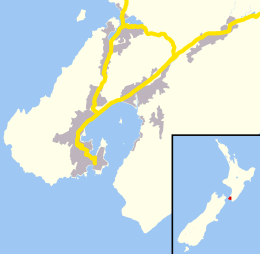Somes Island
| Matiu (Māori) | |
|---|---|

Matiu/Somes Island as seen from Mount Kaukau
|
|
| Geography | |
| Location | Wellington Harbour |
| Coordinates | 41°15′29.7″S 174°51′55.4″E / 41.258250°S 174.865389°E |
| Area | 0.249 km2 (0.096 sq mi) |
| Administration | |
Matiu/Somes Island, at 24.9 ha (62 acres), is the largest of three islands in the northern half of Wellington Harbour, New Zealand. It lies 3 kilometres (1.9 mi) south of the suburb of Petone and the mouth of the Hutt River, and about 5 kilometres (3 mi) northwest of the much smaller Makaro/Ward Island.
Legend has it that both Matiu and Makaro Islands received their original Māori names from Kupe, the semi-legendary first navigator to reach New Zealand and get home again with reports of the new land. He named them after his two daughters (or, in some versions of the tale, nieces) when he first entered the harbour about 1000 years ago.
After European settlement the island was known for over a century as Somes Island. In 1839 it fell under the control of the New Zealand Company along with much of the greater Wellington region. The island was renamed after Joseph Somes, the company's deputy-governor and financier at the time. In 1997 however, the New Zealand Geographic Board assigned the official bilingual name of Matiu/Somes in recognition of the island's colourful European and Māori histories.
Matiu/Somes became part of Lower Hutt in 1989, and came under the full control of the Department of Conservation ("DOC") as a scientific and historic reserve in August 1995. The island is free of introduced mammalian predators (such as stoats), an unusual state for an island so close to an urban centre.
Matiu/Somes Island has had an extensive Māori history and a varied, and a sometimes colourful and tragic, European one. Prior to the mid 17th century there were 2 Māori Pa on the island, however, like the Ngati Ira Pa on Ward Island, they were not permanently inhabited, being "Pa of refuge" where the tribespeople could retreat to in times of war. One was in the centre of the island and little more than the remains of some middens are left there, however there was another Pa on the northern tip of the island, strategically positioned with cliffs on three sides for ease of defence.
...
Wikipedia

